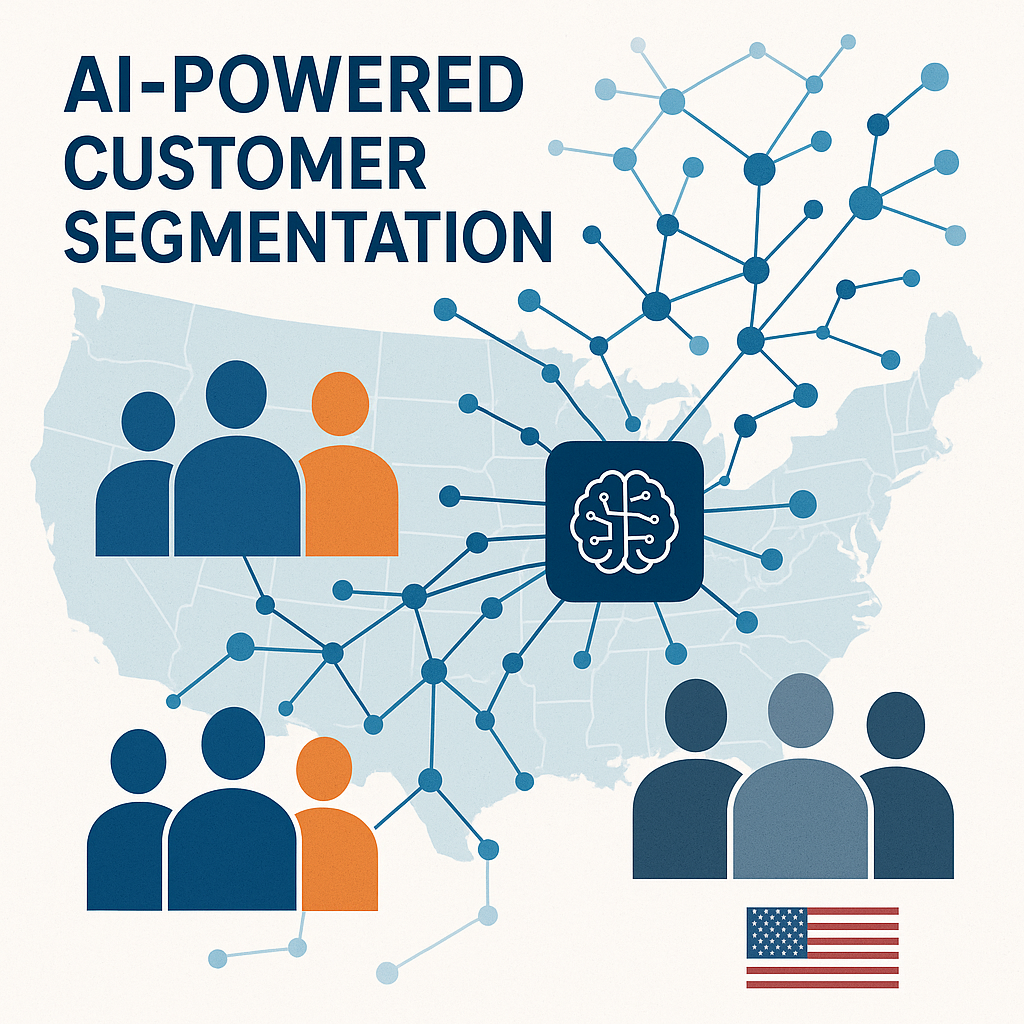
AI-Powered Customer Segmentation: The Ultimate Guide for U.S. Businesses in 2025
In today’s hyper-competitive U.S. market, understanding your customers is more crucial than ever. AI-powered customer segmentation is revolutionizing how businesses analyze, target, and engage their audiences. This comprehensive guide explores how artificial intelligence is transforming customer segmentation, the latest trends for 2025, and actionable strategies for American companies aiming to stay ahead.
What Is AI-Powered Customer Segmentation?
AI-powered customer segmentation leverages artificial intelligence and machine learning algorithms to divide a business’s customer base into distinct groups based on shared characteristics, behaviors, or predicted needs. Unlike traditional segmentation, which relies on manual analysis and basic demographics, AI can process massive datasets, uncover hidden patterns, and deliver highly accurate segments in real time.
TIP: 🧠 AI-driven segmentation goes beyond age and location—it can analyze purchase history, browsing behavior, sentiment, and even predict future actions!
Why U.S. Companies Are Adopting AI-Powered Customer Segmentation in 2025
Key Benefits of AI-Driven Segmentation
- 📈 Increased Personalization: Deliver tailored offers and messages that resonate with each segment.
- ⏱️ Real-Time Insights: Respond instantly to changing customer behaviors and market trends.
- 💰 Higher ROI: Optimize marketing spend by targeting the right audience with the right message.
- 🏆 Competitive Advantage: Stay ahead by leveraging cutting-edge technology for deeper customer understanding.
Latest U.S. Market Trends
- Over 70% of U.S. enterprises now use AI for customer analytics (2025 data).
- Retail, finance, and healthcare sectors are leading adopters.
- Privacy and ethical AI use are top concerns among American consumers.
How Does AI-Powered Customer Segmentation Work?
The AI Segmentation Process
- Data Collection: Gather data from CRM, website, social media, and offline sources.
- Data Cleaning: Use AI to remove duplicates, correct errors, and standardize formats.
- Feature Engineering: Identify key variables (e.g., purchase frequency, product preferences).
- Model Training: Apply machine learning algorithms (like k-means clustering or neural networks).
- Segment Identification: AI uncovers distinct customer groups based on data patterns.
- Actionable Insights: Generate recommendations for marketing, sales, and product teams.
# Example: Simple AI customer segmentation using k-means in Python
from sklearn.cluster import KMeans
import pandas as pd
# Load customer data
data = pd.read_csv('customer_data.csv')
# Select features for segmentation
features = data[['age', 'annual_spend', 'purchase_frequency']]
# Apply k-means clustering
kmeans = KMeans(n_clusters=4, random_state=42)
data['segment'] = kmeans.fit_predict(features)
# View segmented data
print(data.head())
TIP: 🛠️ Even small businesses can start with basic AI tools—no need for a massive data science team!
Top 10 AI-Powered Customer Segmentation Tools for U.S. Businesses (2025)
Choosing the right tool is critical for success. Here are the leading AI segmentation platforms ranked for U.S. companies:
- Salesforce Einstein
- Adobe Sensei
- Microsoft Dynamics 365 AI
- SAS Customer Intelligence 360
- Oracle CX Audience
- Segment (Twilio)
- HubSpot AI Segmentation
- IBM Watson Customer Insights
- Zoho CRM AI
- Amplitude Analytics
Comparison Table: Top AI Customer Segmentation Tools
| Rank | Tool Name | Best For | Key AI Features | U.S. Market Focus | Price Range |
|---|---|---|---|---|---|
| 1 | Salesforce Einstein | Enterprises | Predictive analytics | High | $$$$ |
| 2 | Adobe Sensei | E-commerce, Retail | Real-time segmentation | High | $$$$ |
| 3 | Microsoft Dynamics 365 AI | B2B, Large Orgs | Automated insights | High | $$$ |
| 4 | SAS Customer Intelligence | Financial Services | Deep analytics | Medium | $$$$ |
| 5 | Oracle CX Audience | Multi-channel Marketing | AI-driven targeting | High | $$$$ |
| 6 | Segment (Twilio) | Startups, SaaS | Data unification | Medium | $$ |
| 7 | HubSpot AI Segmentation | SMBs, Agencies | Automated lists | High | $$ |
| 8 | IBM Watson Customer Insights | Healthcare, Finance | Cognitive analytics | Medium | $$$ |
| 9 | Zoho CRM AI | Small Businesses | Lead scoring | Medium | $ |
| 10 | Amplitude Analytics | Product Teams | Behavioral cohorts | Medium | $$ |
TIP: 🏆 Consider your business size, industry, and integration needs when choosing a segmentation tool.
Real-World Applications of AI-Powered Customer Segmentation in the U.S.
Retail
- 📦 Personalized product recommendations
- Dynamic pricing based on segment value
Financial Services
- 🏦 Fraud detection by segmenting risky behaviors
- Tailored financial product offers
Healthcare
- 🏥 Patient engagement campaigns
- Predictive health risk segmentation
E-commerce
- 🎯 Abandoned cart recovery targeting
- Loyalty program optimization
Best Practices for Implementing AI-Powered Customer Segmentation
1. Start With Clear Goals
Define what you want to achieve—higher sales, better retention, or improved customer experience.
2. Ensure Data Quality
AI is only as good as the data you feed it. Clean, accurate, and comprehensive data is essential.
3. Prioritize Privacy and Ethics
Respect customer privacy and comply with U.S. regulations like CCPA.
4. Test and Iterate
Continuously monitor segment performance and refine your models.
5. Align Teams
Ensure marketing, sales, and product teams collaborate on segmentation strategies.
TIP: ✅ Regularly update your AI models to reflect changing customer behaviors and market trends.
Conclusion: Why AI-Powered Customer Segmentation Is Essential for U.S. Businesses in 2025
AI-powered customer segmentation is no longer a futuristic concept—it’s a must-have for U.S. businesses aiming to thrive in 2025. By leveraging advanced machine learning, companies can uncover deep insights, personalize experiences, and drive measurable growth. The latest tools make AI segmentation accessible to organizations of all sizes, from startups to Fortune 500s.
To succeed, focus on clear objectives, maintain high data quality, and choose the right AI platform for your needs. Embrace ethical practices and foster collaboration across your teams. With AI-powered customer segmentation, you’ll not only understand your customers better—you’ll build lasting relationships and outperform the competition in the dynamic American marketplace.